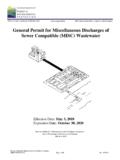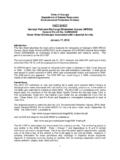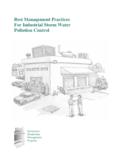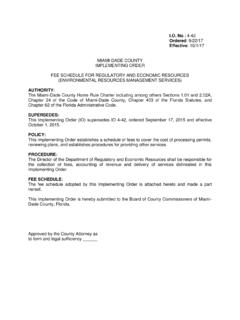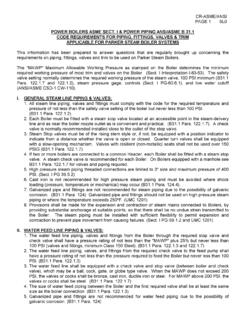Transcription of ILLINOIS URBAN MANUAL - AISWCD
1 Field MANUAL for Inspection of Erosion and Sediment Control Best Management Practices ILLINOIS URBAN MANUAL COVER PHOTO CREDITS: Background Photo: Kendall County SWCD Top Right: ERO-TEX Middle Right: ENCAP, Inc. Lower Right: Jonathon Koepke TABLE OF CONTENTS Preface ..1 Introduction ..2 Planning Principles ..2 Regulations & Requirements ..3 Site Inspection ..4 Practice Selection Guide ..6 Erosion Control, Sediment Control & Misc. Erosion Control Erosion Control Blanket (830) ..7 Mulching for Seeding & Soil Stabilization (875) ..10 Polyacrylamide (PAM) for Temporary Soil Stabilization (893) ..13 Rock Outlet Protection (910).
2 16 Stabilized Construction Entrance (920) ..20 Temporary Seeding (965) ..23 Turf Reinforcement Mat (831) ..25 Sediment Control Culvert Inlet Protection (808) ..28 Dewatering (813) ..31 Ditch Check-Manufactured (814) ..35 Inlet Protection-Paved Areas (861) ..42 Polyacrylamide (PAM) for Turbidity Reduction & Sediment Control (894) ..45 Rock Check Dam (905) ..50 Silt Fence (920) ..54 Sump Pit (950) ..61 Miscellaneous Temporary Concrete Washout Facility ..64 Other Practice Considerations ..70 Acknowledgements ..72 PUBLISHED OCTOBER 2013 EC SC MSC COVER PHOTO CREDITS: Upper Left: Kendall County SWCD Upper Right: ENCAP, Inc.
3 Lower Left: ERO-TEX Lower Right: Jonathon Koepke PREFACE This field MANUAL is intended for use as a technical reference by developers, contractors, planners, engineers, government officials and others involved in inspection of soil erosion and sediment control best management practices on construction sites in ILLINOIS . This field MANUAL was written and reviewed by members of the ILLINOIS URBAN MANUAL Technical Review Committee (TRC) and Steering Committee (SC). Practices found within the field MANUAL are taken directly from the ILLINOIS URBAN MANUAL (IUM) which can be found at: . Please consult the full MANUAL for detailed standards as information contained within the field MANUAL has been abridged.
4 The IUM is a dynamic document currently under revision coordinated and owned by the Association of ILLINOIS Soil & Water Conservation Districts ( AISWCD ) with funding in large part provided by the ILLINOIS Environmental Protection Agency (IEPA) through Section 319 of the Clean Water Act. The initiative to update the IUM is a cooperative effort. The TRC and the SC are actively tasked with the revision of the MANUAL . The SC is comprised of the following public agencies representing the entire State of ILLINOIS : AISWCD , IEPA, Soil & Water Conservation Districts (SWCDs), ILLINOIS Department of Agriculture-Bureau of Land & Water Resources (IDA-BLWR), ILLINOIS Department of Transportation (IDOT), United States Army Corp of Engineers Chicago District (USACE), and United States Department of Agriculture-Natural Resources Conservation Service (USDA-NRCS).
5 The TRC is comprised of the above mentioned public agencies in addition to the following public and private professionals: ILLINOIS Department of Natural Resources-Office of Water Resources (IDNR-OWR), environmental consultants and engineers. ILLINOIS Environmental Protection Agency 1 INTRODUCTION Planning Principles Planning principles are the overall guidelines that need to be considered to select, implement and maintain erosion and sediment control best management practices (BMPs). Erosion and sedimentation are natural geologic processes that human activities often accelerate. Erosion occurs through the action of water or wind. There are three major processes that must be understood to effectively control or limit soil erosion and sedimentation on construction sites.
6 These are detachment, transport, and deposition. Three types of erosion are as follows: Raindrop erosion: Erosion resulting from the direct impact of falling drops of rain on soil particles. This impact dislodges soil particles and splashes them into the air. The dislodged soil particles can then be easily transported by the flow of surface runoff. Sheet Erosion: The removal of a layer of exposed surface soil by the action of raindrop splash and runoff. The water moves in broad sheets over the land and is not confined in small depressions. Rill and Gully Erosion: Occurs after runoff flows concentrate into rivulets, cutting several inches deep into the soil surface.
7 These grooves are called rills. Gullies may develop from rills if not repaired or in other areas where a concentrated flow of water moves over the soil. Many of the BMPs included in the field MANUAL will individually address one or more types of erosion. Of these, most will impact the detachment or movement of sediment or provide storage methods. This MANUAL categorizes BMPs into the following: Erosion Control Sediment Control Miscellaneous The most important, and most often neglected, task is to provide effective soil stabilization by employing erosion control measures throughout the duration of a construction project. Soil stabilization is based on a simple premise: if water cannot detach the soil, it cannot be transported ( , erosion does not occur).
8 The easiest, most economical, and environmentally sound way to prevent detachment is by keeping a good vegetative cover in place. One way this can be done is by minimizing soil disturbance. It also can be accomplished via other techniques such as mulching or use of erosion control blanket. 2 Planning Principles (continued) Once the soil is detached, flowing water transports the soil to downslope positions. Sediment control measures are needed to filter, trap or otherwise remove eroded sediments before they can leave the construction site. Additionally, sediment control measures can provide runoff control which is needed to deal with concentrated runoff. Concentrated runoff is a common occurrence on large sites containing existing drainageways and is made more severe by grading activities that removes water absorbent topsoil and compacts underlying soils.
9 If concentrated runoff occurs, it will further erode the soil and carry it into streams, lakes, or road ditches. The basic principles behind runoff control measures are to provide stabilized channels for runoff water and to divert concentrated runoff from exposed, erodible soils. In implementing the erosion and sediment control BMPs described in the field MANUAL , it is important to understand them in the context of an overall construction site plan. Selection and design of BMPs must involve more than just choosing a practice from a list and installing it on a site. It also involves a planning process which considers areas for protection, the problem to be avoided, or remediated, and also factors in the characteristics of a site.
10 Effective site planning and design will result in minimal impacts to water quality, natural hydrologic characteristics and sensitive landscape features. Site design and the application of sound planning principles are critical factors in achieving effective soil erosion and sediment control. 3 Regulations & Requirements What the law requires: Water Quality Regulations The United States Army Corps of Engineers (USACE) and United States Environmental Protection Agency (USEPA) are the two federal agencies that regulate water quality. Both agencies have authority under the Clean Water Act (CWA) of 1977. Specifically, the USACE has authority under Section 404 of the CWA of 1977.


